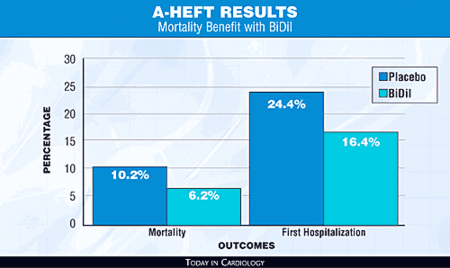FDA approves BiDil for HF treatment in blacks
Agent is sole therapy for enhancing nitric oxide, a mechanism critical to slowing progression of HF in this population.
The Food and Drug Administration has approved BiDil, the first heart failure therapy specifically indicated for blacks.
BiDil is a combination of isosorbide dinitrate and hydralazine hydrochloride (NitroMed Inc.). The exact mechanism for BiDil is unknown, but researchers suspect it has something to do with its ability to enhance nitric oxide. “None of the other heart failure drugs that we use work through that mechanism. ACE inhibitors may have a partial effect to enhance nitric oxide, but it’s only a small part of their effect,” said Jay Cohn, MD, professor of medicine at the University of Minnesota Medical School.
“BiDil is really the sole therapy for enhancing nitric oxide. We know that in African-American patients enhancing nitric oxide is critical to slowing progression of the disease,” said Cohn, who invented the BiDil compound. “Every African-American with heart failure should be taking this drug, whatever background therapy they are on.”
Cohn is an editorial board member of Cardiology Today’s Myocardial Disorders, HF and Transplantation section.
BiDil will be priced at $1.80 per tablet, but the company expects to offer the drug free of charge to patients without insurance coverage whose annual household incomes are up to three times the poverty level.
For all others without insurance coverage, NitroMed Inc. said it plans to make BiDil available for $25 per prescription.
Specialized medicine
BiDil investigator Anne Taylor, MD, professor and associate dean at the University of Minnesota, said it would likely not be the last race-based approval from FDA. “We are in an era of specialized medicine already and have been for some time,” she said.
“It’s appropriate if there are differences between ethnic groups that one should investigate and develop. It isn’t always the case that there are ethnic differences, but when you have a trail of evidence based on either epidemiologic data or previous clinical trials showing that there is a valid reason to look at groups, then it is appropriate to pursue that.”
Cohn agreed, saying that this may be the first step of a generalized trend to develop drugs in specific populations. “We have a large population of Hispanics and a large population of Asians that have different geographical origins and probably will exhibit differences in response to drugs as well as differences in mechanisms of disease.
“I think it’s critical in the future that we develop therapies and determine how they work in these populations,” he said.
Drug indication/regimen
BiDil is indicated to improve survival, prolong time to hospitalization for HF and improve patient-reported functional status as an adjunct to current standard HF therapy in self-identified black patients.
The approval, which quickly followed a unanimous recommendation from the Cardiovascular and Renal Drug Advisory Committee, was based on the results of the African American Heart Failure Trial (A-HeFT).
A-HeFT was halted early in July 2004 due to a significant mortality benefit seen with the drug. Patients taking BiDil had an absolute mortality rate of 6.2% compared to 10.2% on placebo, a 43% risk reduction (P=.012).
 |
Other outcomes were similarly pronounced with a 39% reduction in the risk of first hospitalization (16.4% vs. 24.4%, P<.001), and a statistically significant improvement at most time points in response to the Minnesota Living with Heart Failure Questionnaire.
According to FDA documents, BiDil is orally administered initially at one tablet, three times per day. This may be increased to a maximum of two tablets, three times per day based on patient tolerance. Adjustment to maximum dosage may occur in three to five days. – by Jeremy Moore
